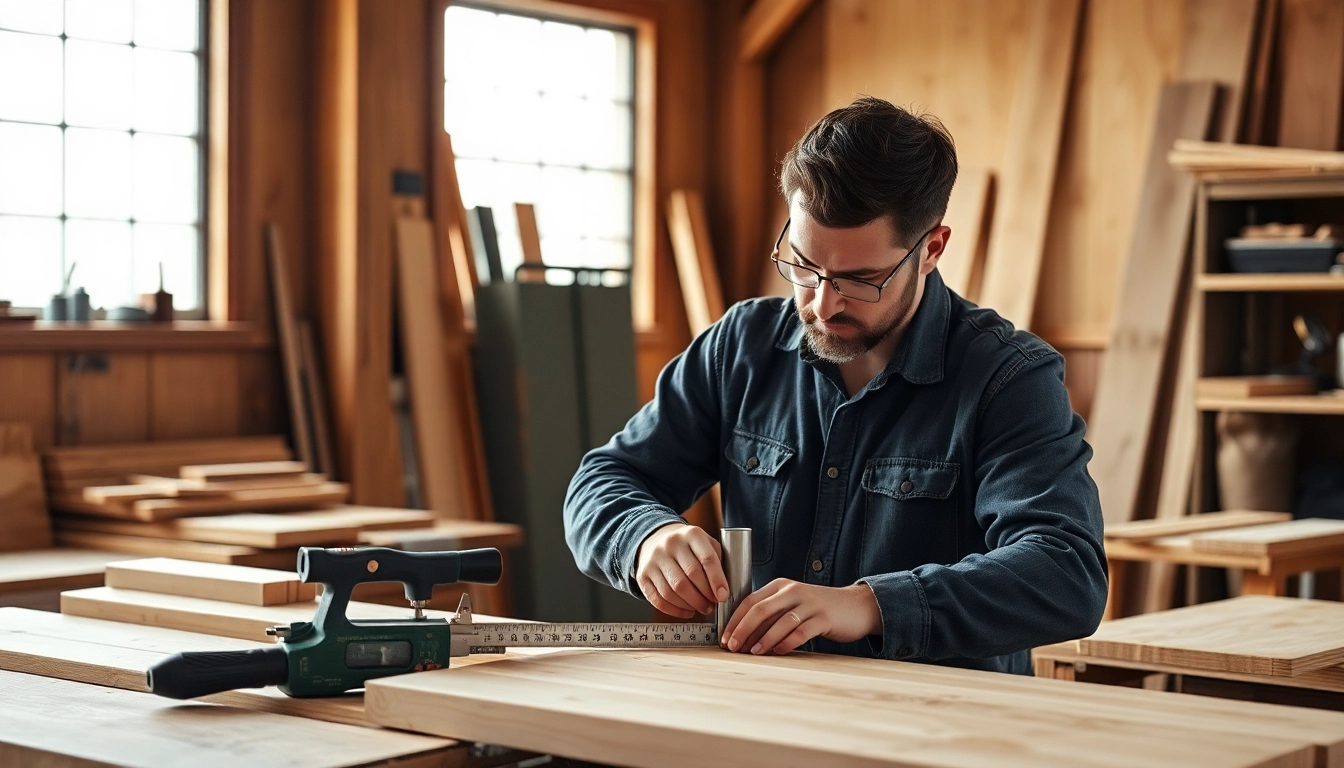Understanding the Role of a Carpenter in Modern Construction
In the dynamic world of construction and renovation, the role of a Carpenter stands out as fundamental to bringing architectural visions to life. Carpenters are skilled artisans responsible for constructing, repairing, and installing building frameworks and structures made primarily from wood—but often incorporating other materials as well. Their expertise not only ensures structural integrity but also enhances aesthetic appeal, making their craft indispensable in both residential and commercial projects. Whether it involves framing a new building, crafting custom furniture, or remodeling existing spaces, carpenters combine technical skill with artistry to deliver high-quality results. Understanding their roles, skills, and the nuances of their work is essential for clients, contractors, and aspiring professionals aiming to excel in this craft.
What Do Carpenters Do in Building Projects?
Carpenters are the backbone of the construction industry, charged with a diverse array of tasks that vary based on specialization and project scope. Their core responsibilities include constructing the skeletal framework of buildings, installing doors, windows, cabinetry, and fixtures, and finishing interiors with precision detail. According to the Occupational Outlook Handbook, they primarily “construct, repair, and install building frameworks and structures made from wood and other materials,” which underscores their versatility and expertise in handling various materials and techniques.
In a typical building project, carpenters are involved from initial site preparation through to completion. They interpret blueprints and technical drawings to develop accurate plans and measurements, ensuring each element aligns with safety standards and design specifications. For example, in residential construction, a carpenter might build the walls, floor, and roof structures, frame doorways, and install custom trim. In commercial projects, they might work on larger-scale frameworks and concrete forms. Their roles also extend into renovation works, where they repair or modify existing structures, often blending traditional skills with modern engineering methods. The ability to adapt swiftly to the project’s evolving needs and resolve unforeseen challenges is a hallmark of a professional carpenter.
Different Types of Carpenters and Specializations
Carpentry is a broad trade with various specializations, each demanding specific skills and knowledge areas. Understanding these classifications helps clients and professionals identify the right expert for their project needs:
- Rough Carpenters: Focused on the structural framework of buildings, including framing walls, floors, and roofs. They work on the skeletons that support the entire structure, ensuring alignment, stability, and safety.
- Finish Carpenters: Specialize in detailed and decorative work such as installing trim, moldings, cabinets, staircases, and other interior fixtures that require meticulous craftsmanship.
- Residential Carpenters: Concentrate on home construction, remodeling, and renovations. Their expertise ranges from framing to custom carpentry tailored to homeowners’ specifications.
- Commercial Carpenters: Handle larger-scale projects like office buildings, retail spaces, and public infrastructure, often involving complex frameworks and adherence to stricter safety regulations.
- Industrial Carpenters: Engage in specialized tasks related to industrial settings, such as constructing scaffolding, formworks for concrete, or working with heavy-duty materials.
- Trim and Cabinetry Carpenters: Focus on the aesthetic and finishing touches, crafting and installing detailed woodwork that enhances interior design.
These categories often overlap, and many carpenters develop expertise across multiple areas. Specialized training and experience allow each type to excel in their respective domains, ensuring efficiency, quality, and safety in every phase of construction or renovation.
Skills and Qualifications of a Professional Carpenter
Exceling as a carpenter requires a combination of technical skills, physical dexterity, and soft competencies. Key skills and qualifications include:
- Technical Knowledge: Mastery of blueprint reading, measurement techniques, and familiarity with building codes and safety regulations.
- Precision and Attention to Detail: Ensuring accurate cuts, seamless joints, and perfect alignments to meet design specifications and safety standards.
- Physical Strength and Stamina: Ability to handle heavy materials, work at heights, and perform physically demanding tasks for extended periods.
- Problem-Solving Skills: Diagnosing issues on-site and adapting plans to unforeseen conditions or material limitations.
- Communication and Collaboration: Working effectively with architects, contractors, and clients to ensure project goals are met accurately and timely.
- Training and Certification: Most carpenters undertake vocational training, apprenticeships, or technical programs. Many also pursue certifications in safety procedures and specialized areas such as cabinetry or formwork.
Proficiency in using a wide array of hand tools, power tools, and modern machinery is essential for efficiency and safety. Continuous education and staying updated with industry innovations, materials, and techniques are vital for maintaining a competitive edge and delivering superior craftsmanship.
How to Choose the Right Carpenter for Your Project
Factors to Consider When Hiring a Carpenter
Selecting the ideal carpenter involves evaluating several critical factors to ensure quality, reliability, and value. Consider the following:
- Experience and Specialization: Look for a contractor with proven experience relevant to your project’s scope—be it framing, cabinetry, or renovations.
- Reputation and References: Seek reviews, testimonials, and references from previous clients to gauge their satisfaction and the quality of work.
- Licensing and Insurance: Verify that the carpenter holds necessary licenses and carries insurance to protect against accidents or damages.
- Portfolio of Past Projects: Review their portfolio to assess craftsmanship, attention to detail, and compatibility with your aesthetic vision.
- Cost and Timeline Estimates: Obtain clear, detailed quotes and realistic completion timelines to avoid surprises or delays.
Questions to Ask During the Selection Process
Effective communication is key to a successful project. Important questions include:
- Can you provide references from recent clients?
- What is your experience with projects similar to mine?
- What is your estimated timeframe and total cost for the project?
- How do you handle unforeseen issues or delays?
- Which materials do you recommend for durability and cost-effectiveness?
- Are you licensed, bonded, and insured?
- Do you provide a written contract outlining scope, costs, and timelines?
How to Verify a Carpenter’s Experience and Reputation
To ensure you’re hiring a qualified professional, verify their credentials through multiple avenues. Contact previous clients, review online ratings and testimonials, and check licensing boards or trade associations for certification status. Visiting ongoing or completed job sites can also provide insight into their work quality and professionalism. In addition, consider asking about their safety record and ongoing training efforts, which signal their commitment to industry standards and continuous improvement.
Cost, Rates, and Budgeting for Carpentry Work
Average Hourly and Project-Based Rates
Understanding current market rates is critical for budgeting. According to industry data, the average hourly rate for carpenters ranges from $75 to $125. For larger, more complex projects, costs can escalate up to $200 per hour. For project-based work, typical costs vary depending on scope, complexity, and region, but a standard residential framing or finish carpentry project might cost between $5,000 and $25,000. It is essential to obtain detailed estimates that specify labor, materials, and contingencies to facilitate accurate budgeting.
Cost Factors Influencing Carpentry Pricing
Several factors determine the final cost of carpentry projects:
- Material Quality: High-end woods and specialty materials increase costs but offer greater durability and aesthetic appeal.
- Project Size and Complexity: Larger or more intricate projects require more labor, precision, and time, affecting overall pricing.
- Location and Regional Rates: Labor costs and material prices vary geographically, influencing total costs.
- Timeline Urgency: Expedited projects may incur higher rates due to overtime or scheduling adjustments.
- Design and Customization: Tailored designs or custom features tend to be more expensive than standard models.
Budgeting Tips to Maximize Value
Efficient budgeting involves balancing quality and affordability. Here are practical tips:
- Get multiple bids to compare prices and offerings.
- Prioritize essential features, and consider phased projects for expensive elements.
- Opt for durable, maintenance-friendly materials to reduce future repair costs.
- Invest in experienced carpenters with strong reputations to ensure quality workmanship.
- Clearly define project scope and expectations upfront with detailed contracts.
Best Practices for Working with a Carpenter
Design Discussions and Planning
Successful projects begin with clear, comprehensive planning. Engage your carpenter early to discuss design ideas, functionality, and aesthetic preferences. Utilizing detailed blueprints or 3D modeling can facilitate understanding and alignment. Effective communication ensures the project stays on track, reduces revisions, and enhances the final outcome.
Material Selection and Durability
Choosing the right materials is crucial for durability, appearance, and budget management. Carpenters can advise on optimal woods—such as oak, maple, or cedar—based on environmental exposure and usage. Additionally, selecting quality hardware, finishes, and sealants enhances longevity and ease of maintenance. Consider sustainability and eco-friendliness when possible, which adds value and aligns with consumer preferences.
Ensuring Quality and Safety Standards
Adherence to safety and quality standards is non-negotiable. Verify that the carpenter complies with local building codes and safety regulations. Regular site inspections and progress reviews help identify potential issues early. Using appropriate protective equipment, secure scaffolding, and proper handling of tools safeguard workers and occupants alike. A professional carpenter prioritizes safety without compromising craftsmanship.
Enhancing Your Space with Expert Carpentry Solutions
Custom Furniture and Fixtures
One of the most realized benefits of skilled carpentry is the creation of bespoke furniture and architectural fixtures. Custom kitchens, built-in shelves, elaborate staircases, and unique furniture pieces can transform spaces, adding personalization and increasing property value. Collaborate closely with your carpenter to select materials, styles, and finishes that complement your interior design and functional needs.
Renovation and Remodeling Projects
Carpenters play a vital role in remodeling, whether upgrading an existing kitchen, expanding a living room, or restoring historic structures. Their ability to adapt and modify frameworks, install new fixtures, and integrate modern elements with old designs ensures seamless transformations. Proper planning and skilled execution can substantially increase the longevity and aesthetic appeal of renovated spaces.
Maintaining and Extending the Life of Carpentry Work
Proper maintenance prolongs the lifespan of carpentry installations. Regular inspections for damage or wear, timely repairs, and protective finishes help preserve quality. Educating clients on cleaning and care routines enhances durability, ensuring that investments in craftsmanship remain attractive and functional for years to come.



